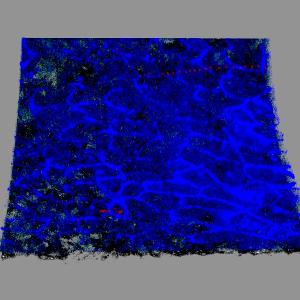2023-11-02 ミュンヘン大学(LMU)

Inner surface of a carotid artery from a mouse treated with the target site blocker; endothelial protein CD in blue. | © Weber Lab, IPEK
◆研究では、動脈内皮細胞および平滑筋細胞でのCXCR4タンパク質の発現を抑制するために、miR-206と呼ばれるmicroRNA分子を利用し、動脈硬化の予防に成功しました。この方法は、細胞特異的な遺伝子発現を微調整するための費用対効果の高い方法として注目されています。
<関連情報>
- https://www.lmu.de/en/newsroom/news-overview/news/atherosclerosis-rna-fragment-creates-prospect-for-new-therapies.html
- https://www.science.org/doi/10.1126/scitranslmed.adf3357
CXCR4の細胞特異的マイクロRNAリプレッサーを標的とすることで、マウスのアテローム性動脈硬化症が改善される Targeting a cell-specific microRNA repressor of CXCR4 ameliorates atherosclerosis in mice
Ismail Cimen,Lucia Natarelli,Zahra Abedi Kichi,James M. Henderson,Floriana M. Farina,Eva Briem,Maria Aslani,Remco T.A. Megens,Yvonne Jansen,Elizabeth Mann-Fallenbuchel,Selin Gencer,Johan Duchêne,Maliheh Nazari-Jahantigh,Emiel P.C. van der Vorst,Wolfgang Enard,Yvonne Döring,Andreas Schober,Donato Santovito,and Christian Weber
Science Translational Medicine Published:1 Nov 2023
DOI:https://doi.org/10.1126/scitranslmed.adf3357
Editor’s summary
The C-X-C motif chemokine receptor 4 (CXCR4) is important for vascular integrity, but boosting CXCR4 to treat atherosclerosis is limited by on-target effects in nonvascular cells. Here Cimen et al. showed that the microRNA miR-206-3p is a vascular-specific repressor of CXCR4 and that disrupting this repression with an mRNA target-site blocker increased CXCR4 in vascular cells in vitro. In a mouse model of atherosclerosis, treatment with the target-site blocker after disease onset reversed pathology and improved CXCR4 function. Human atherosclerotic plaques also had decreased CXCR4 and increased miR-206-3p, supporting the preclinical findings. These results suggest that increasing CXCR4 in vascular cells might be a potential therapeutic strategy for atherosclerosis in humans. —Brandon Berry
Abstract
The CXC chemokine receptor 4 (CXCR4) in endothelial cells (ECs) and vascular smooth muscle cells (VSMCs) is crucial for vascular integrity. The atheroprotective functions of CXCR4 in vascular cells may be counteracted by atherogenic functions in other nonvascular cell types. Thus, strategies for cell-specifically augmenting CXCR4 function in vascular cells are crucial if this receptor is to be useful as a therapeutic target in treating atherosclerosis and other vascular disorders. Here, we identified miR-206-3p as a vascular-specific CXCR4 repressor and exploited a target-site blocker (CXCR4-TSB) that disrupted the interaction of miR-206-3p with CXCR4 in vitro and in vivo. In vitro, CXCR4-TSB enhanced CXCR4 expression in human and murine ECs and VSMCs to modulate cell viability, proliferation, and migration. Systemic administration of CXCR4-TSB in Apoe-deficient mice enhanced Cxcr4 expression in ECs and VSMCs in the walls of blood vessels, reduced vascular permeability and monocyte adhesion to endothelium, and attenuated the development of diet-induced atherosclerosis. CXCR4-TSB also increased CXCR4 expression in B cells, corroborating its atheroprotective role in this cell type. Analyses of human atherosclerotic plaque specimens revealed a decrease in CXCR4 and an increase in miR-206-3p expression in advanced compared with early lesions, supporting a role for the miR-206-3p–CXCR4 interaction in human disease. Disrupting the miR-206-3p–CXCR4 interaction in a cell-specific manner with target-site blockers is a potential therapeutic approach that could be used to treat atherosclerosis and other vascular diseases.


